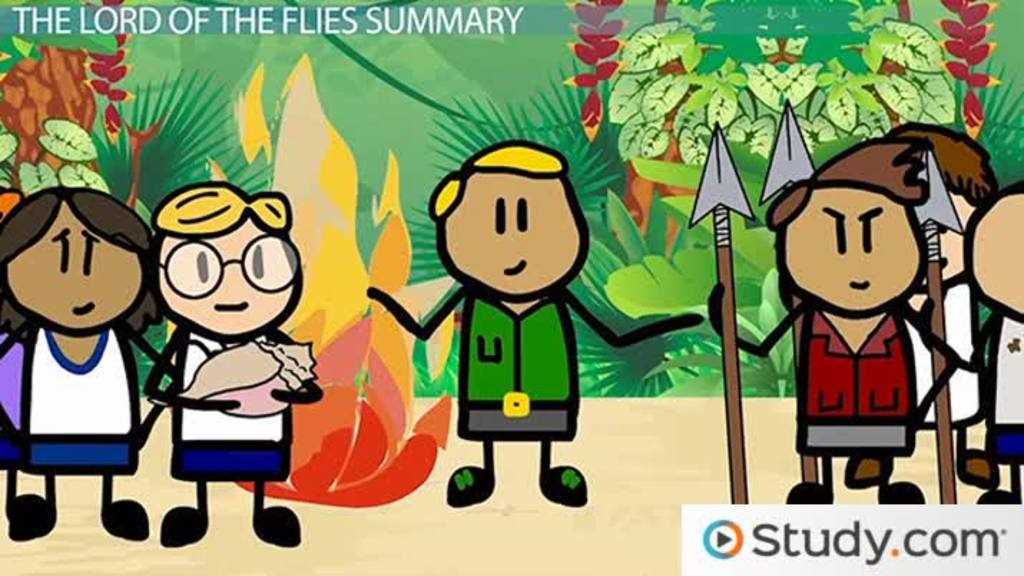
In this crucial segment of the novel, significant developments unfold that shape the characters’ journeys and highlight core themes. The narrative takes a dark turn, bringing to the forefront the complexities of survival, human instincts, and societal breakdown. This part focuses on key moments that stir both action and reflection, pushing the plot toward its deeper philosophical questions.
Through pivotal events and powerful imagery, the author explores the fragility of civilization and the destructive potential of fear. Character interactions intensify as their individual choices reflect their inner struggles, revealing essential truths about human nature. Understanding these moments helps unravel the larger motifs and symbols present in the story.
By delving into the challenges faced by the group, readers are invited to consider broader questions about leadership, morality, and chaos. The unfolding drama offers a unique opportunity to reflect on how specific events change the course of the story, leaving lasting impressions on the characters and their relationships.
Understanding the Key Events in Chapter 9
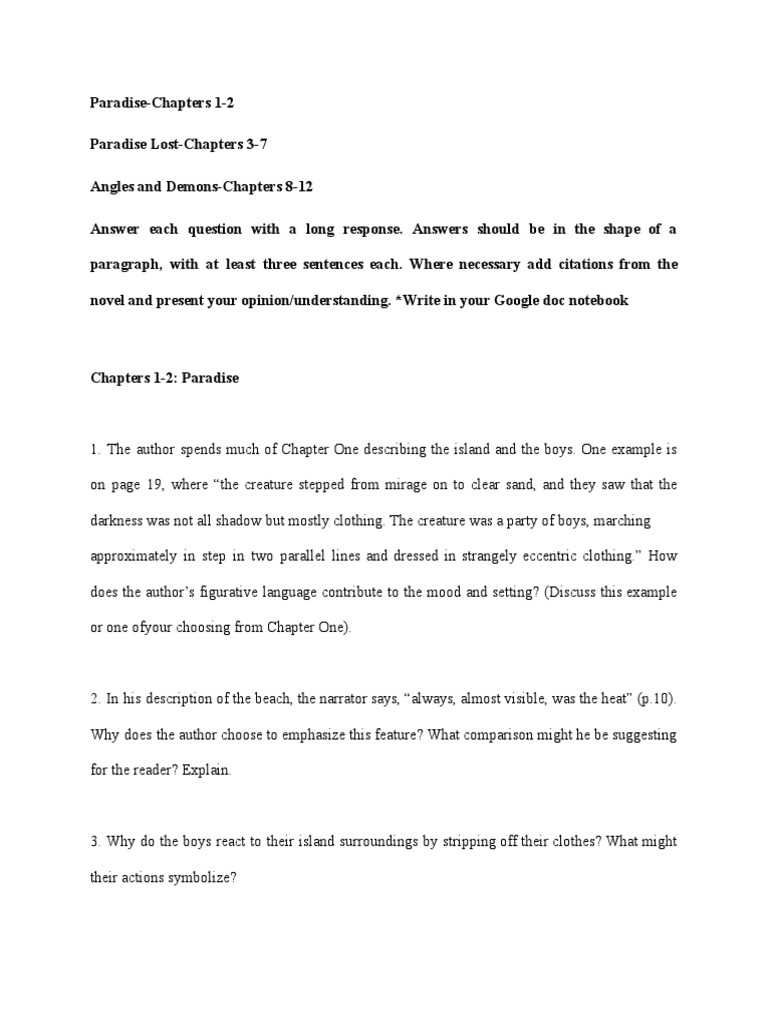
This part of the story marks a turning point, where the tension among the group reaches its peak. Critical events unfold that have profound consequences on both individual characters and their collective behavior. The unfolding drama brings out the darker aspects of human nature and pushes the narrative toward its inevitable clash between civilization and savagery.
The Tragic Death of Simon
One of the most significant events in this section is Simon’s death. His tragic end occurs in a frenzy of fear and misunderstanding, symbolizing the ultimate collapse of order within the group. As the boys, overcome by hysteria, mistake Simon for the beast, the scene represents a loss of innocence and the triumph of irrational fear. This moment also highlights the theme of sacrifice, where Simon’s death can be seen as a grim commentary on humanity’s darker impulses.
The Beast Within
Another key element is the symbolic role of the beast, which is a constant source of fear throughout the story. In this section, the beast is not a physical entity but a manifestation of the boys’ inner fears. The group’s descent into chaos is marked by their growing belief in this imaginary monster, illustrating how fear can distort reality and lead to destructive actions. This event serves as a powerful reminder of how easily fear can manipulate and divide individuals.
- The mob mentality intensifies as fear escalates.
- Simon, a figure of peace, becomes a victim of collective violence.
- The group’s descent into chaos shows the breakdown of moral and social order.
In conclusion, these events are pivotal in understanding the central themes of the narrative. They reflect the complex dynamics within the group, as well as the broader philosophical questions about human nature. The death of Simon and the manifestation of the beast are not just plot points but crucial moments that push the story toward its inevitable exploration of civilization’s fragility.
Analysis of Simon’s Death in Chapter 9
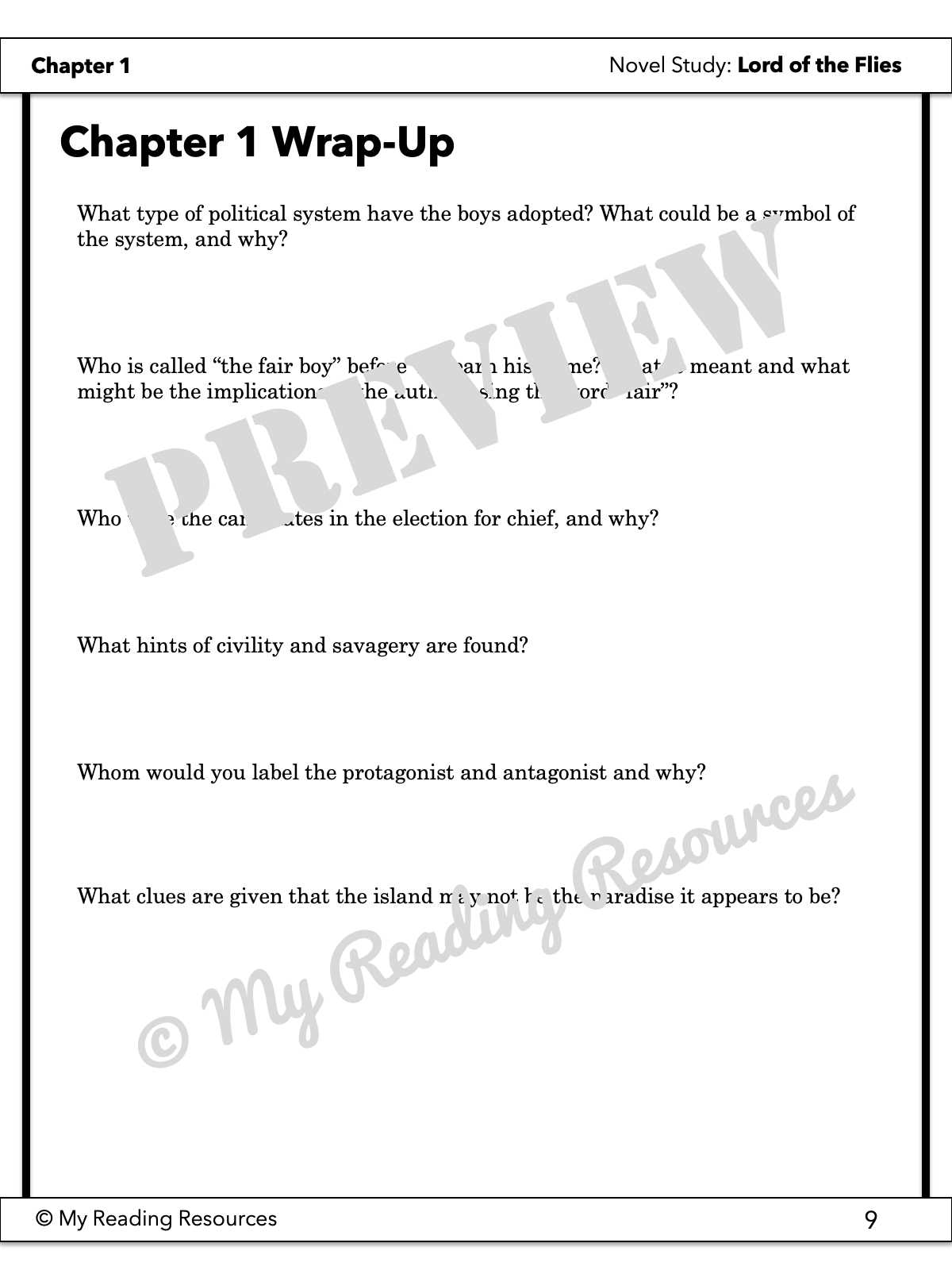
Simon’s death represents a turning point in the narrative, marking the culmination of growing tension and fear among the boys. His tragic end is not simply the loss of a character, but a profound symbol of innocence destroyed by collective violence and fear. The moment serves as a critical commentary on human nature and the breakdown of social structures in the face of irrationality.
In this section, Simon attempts to reveal the truth about the supposed “beast” to the group, only to be mistaken for the very creature they fear. His death, therefore, is not an accident but a consequence of the group’s hysteria and mob mentality. The boys, caught in a frenzy, act without reason, illustrating how easily individuals can be swept up by the emotions of a crowd, losing their moral compass in the process.
Simon’s death can also be seen as a tragic representation of the failure of reason and the triumph of chaos. Throughout the story, Simon stands as a figure of peace and insight, often removed from the madness of the others. His death highlights the danger of ignoring wisdom and the consequences of surrendering to base instincts.
Ultimately, Simon’s fate underscores one of the central themes of the story: the fragility of civilization and the ease with which humanity can descend into barbarism. The event serves as a stark reminder of the destructive power of fear and the loss of individual responsibility in a collective society.
How the Beast Represents Fear in the Novel
Throughout the narrative, the beast serves as a powerful symbol of the deep-seated fear that resides within each individual. It is not a physical creature but an embodiment of the irrational fears and anxieties that plague the boys. As their understanding of the world breaks down, the concept of the beast grows, becoming a more tangible force that drives their actions and decisions.
Manifestation of Inner Fears
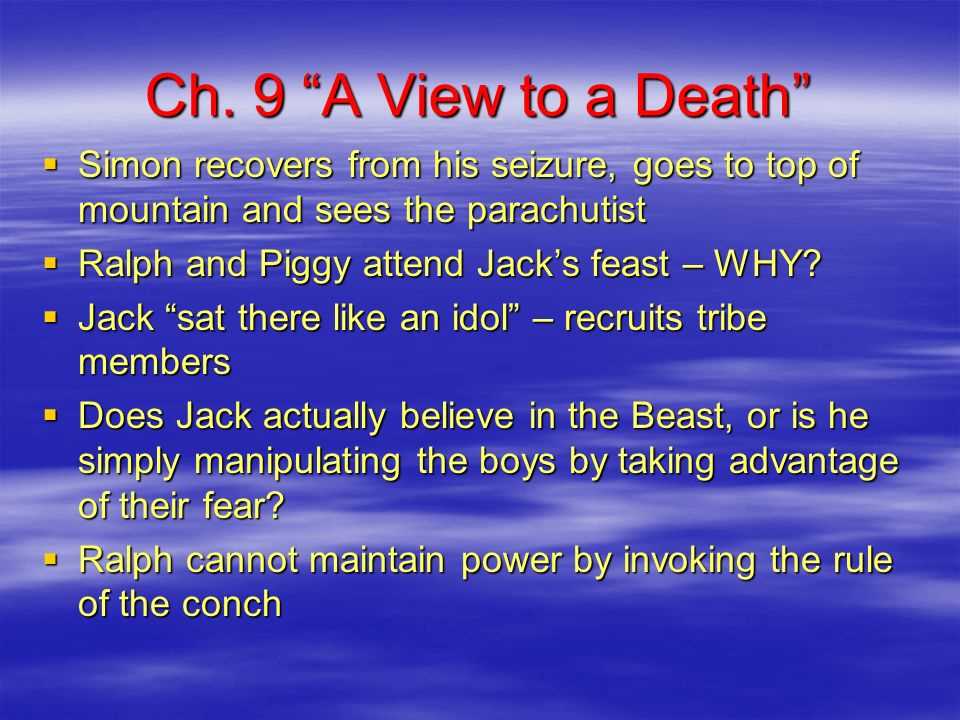
The beast is initially imagined as a monstrous entity lurking in the shadows, but as the story progresses, it becomes clear that it represents much more than a mere physical threat. It symbolizes the fear of the unknown, the fear of what lurks inside each person, and the fear of losing control. The more the boys focus on it, the more real it becomes to them, illustrating how fear can distort reality and shape behavior. The creature grows in significance as it becomes a projection of their collective anxieties.
How Fear Drives Group Behavior
As the fear of the beast intensifies, it begins to influence the group’s decisions, creating division and chaos. The boys’ collective panic leads to irrational acts, such as Simon’s tragic death, which is driven by the belief that he is the beast. This scene highlights how fear, when allowed to dominate, can lead to violent and destructive behavior, causing the group to lose touch with reason and morality. The beast, therefore, serves as a mirror for the boys’ descent into savagery, showing how fear can overcome logic and foster a sense of unity through shared terror.
In conclusion, the beast is not just a symbol of external danger, but of the internal fears that consume the characters. It becomes a vehicle for exploring deeper psychological and societal themes, demonstrating the destructive power of fear when it is allowed to fester unchecked.
The Role of the Storm in Chapter 9
The storm in this section plays a pivotal role, not only in altering the atmosphere but also in enhancing the thematic depth of the story. It is more than just a weather event; it mirrors the emotional turbulence and chaos that the boys are experiencing. The storm creates a sense of impending doom, heightening the tension and signaling a dramatic shift in the narrative. It emphasizes the uncontrollable forces that are shaping the events and the characters’ fate.
A Symbol of Inner Conflict
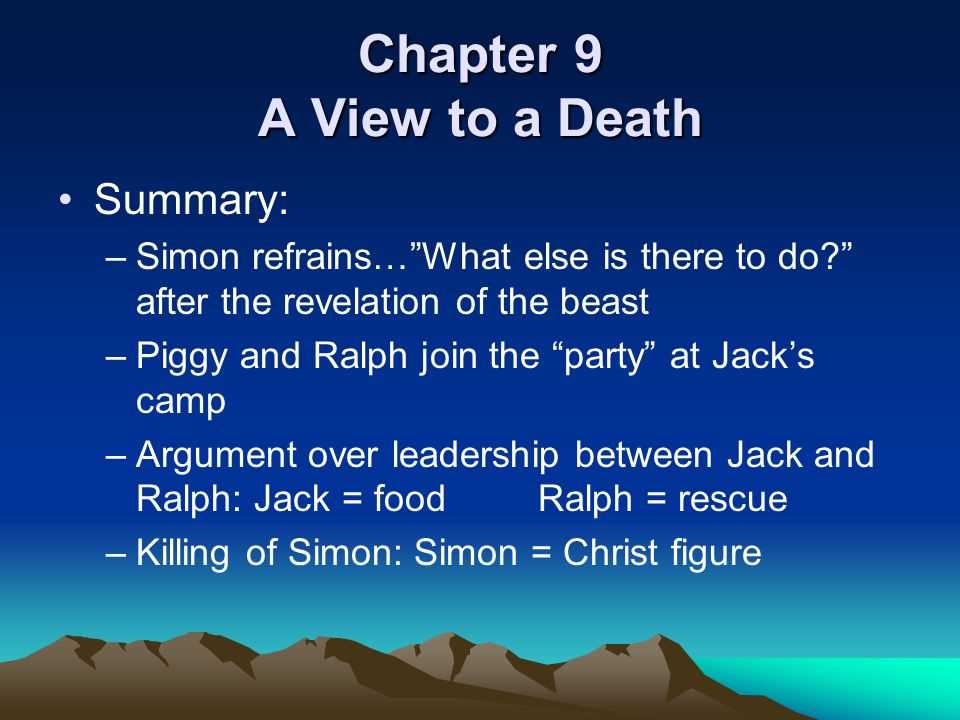
The storm’s violent presence reflects the turmoil within the group, as their fragile sense of order begins to crumble. As the wind howls and rain pours down, the boys’ behavior becomes more erratic, paralleling the storm’s unpredictability. The powerful forces of nature serve as a backdrop to the violence that unfolds, amplifying the sense of chaos and foreboding. It underscores the idea that, just like the storm, the boys’ fears and instincts are uncontrollable and destructive.
Enhancing the Tragic Atmosphere
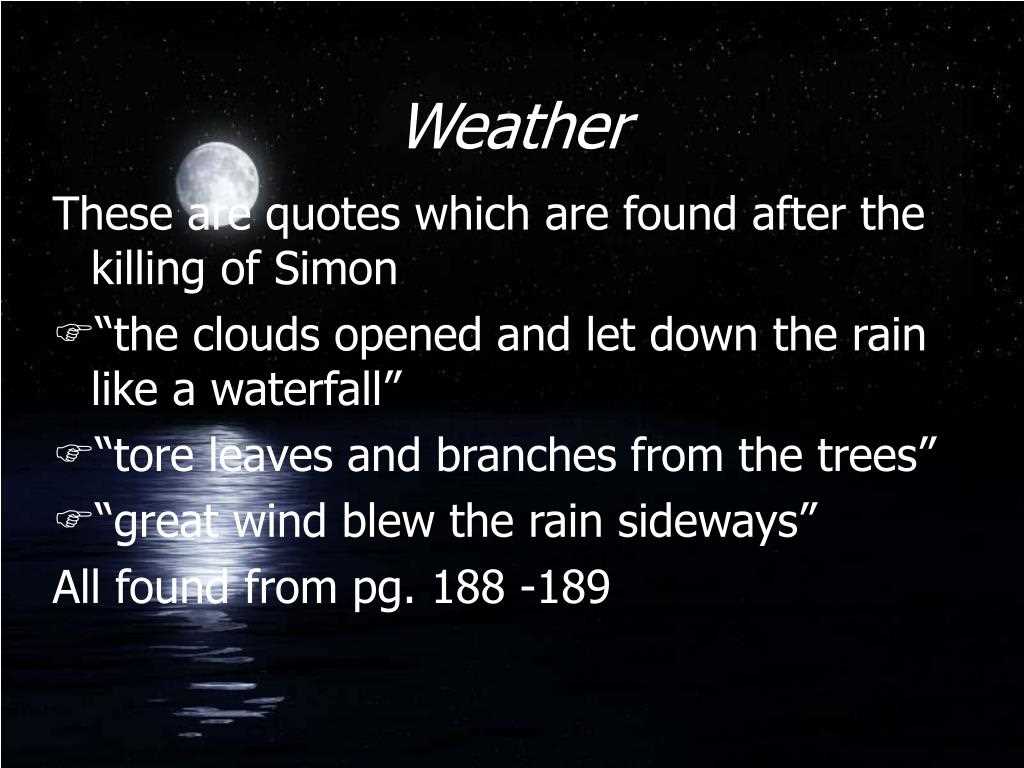
As the storm reaches its peak, so does the madness within the group. The relentless weather creates an oppressive environment, symbolizing the darkness overtaking their minds. It heightens the isolation of Simon, whose death occurs in the midst of this tempest. The storm intensifies the sense of despair, making the tragic events even more powerful. It is as though nature itself is conspiring with the boys’ fears, driving them toward their tragic fate.
In summary, the storm serves as more than just a natural occurrence. It acts as a symbolic force that mirrors the emotional and psychological states of the characters, adding to the tension and highlighting the breakdown of order and reason. It is an essential element that reinforces the central themes of chaos and destruction.
Exploring Ralph’s Leadership Struggles
Throughout the narrative, Ralph faces significant challenges in maintaining control over the group. His leadership is constantly tested by external threats and internal divisions. As the boys’ situation becomes increasingly chaotic, Ralph’s ability to lead effectively deteriorates, exposing the fragile nature of authority in a survival situation. His struggle represents the conflict between order and chaos, highlighting the difficulty of keeping a group united under pressure.
One of Ralph’s primary struggles is balancing the practical aspects of survival with the growing tension within the group. His attempt to create a structured society is undermined by the rise of fear, violence, and anarchy among the boys. As the group becomes more divided, Ralph’s influence weakens, revealing the limitations of his leadership and the overwhelming power of primal instincts.
Factors Affecting Ralph’s Authority
| Challenge | Impact on Leadership |
|---|---|
| Lack of unity within the group | Weakens Ralph’s ability to make decisions and maintain order. |
| Emerging fear and hysteria | Creates divisions, making it difficult for Ralph to enforce rational thinking. |
| Power struggle with Jack | Undermines Ralph’s authority and leads to a shift in control. |
| Loss of faith in leadership | Decreases the group’s trust in Ralph, leading to rebellion and chaos. |
In conclusion, Ralph’s leadership struggles underscore the theme of societal breakdown and the complexities of governance. Despite his efforts to uphold order, his authority is gradually eroded by fear, power dynamics, and the inherent challenges of survival. These struggles reflect the fragility of civilization and the difficulty of maintaining control in a crisis.
The Symbolism of the Dead Parachutist
The dead parachutist serves as a powerful symbol in the narrative, representing the external world and the reality of war that is far removed from the boys’ island. His arrival, coinciding with a moment of great fear and confusion, highlights the fragility of civilization and the inevitability of violence. The parachutist is not merely a corpse caught in the wind; he embodies the consequences of conflict and the collapse of order that is occurring within the boys’ society.
Contrasting Civilized Society with Chaos
The parachutist, falling from the sky, represents the intrusion of external violence into the boys’ isolated existence. His descent signals that the world outside is not free from conflict and war, reinforcing the idea that even in a remote setting, the impacts of civilization’s breakdown are inescapable. The figure is mistaken for the “beast,” further emphasizing how the boys’ perception of the world is distorted by fear and chaos. His presence on the island serves as a reminder of the destructive forces of war and human conflict.
Symbol of Hope and Futility
While the parachutist might be seen as a symbol of hope – suggesting that help could be on the way – it also carries an element of futility. His lifeless body, tangled in the trees, signifies that any hope of rescue is unreachable or unattainable. His death is a stark contrast to the boys’ own desperate desires for salvation, emphasizing the disillusionment they face. The presence of the dead parachutist further illustrates the theme of helplessness and the inescapability of death and destruction.
| Symbol | Meaning |
|---|---|
| Parachutist | Represents the outside world and the violence of war. |
| His descent | Signifies the collapse of order and the intrusion of chaos into the boys’ lives. |
| Tangled body | Symbolizes the futility of rescue and the inevitability of death. |
| Mistaken for beast | Reflects how fear distorts reality, leading to violence and misunderstanding. |
In conclusion, the dead parachutist is a multifaceted symbol that enriches the themes of the novel. His arrival on the island not only signifies the pervasive nature of war but also reflects the boys’ lost hope and the disintegration of civilization. His death serves as a reminder of the inescapable reality of human conflict and the consequences of abandoning social order.
The Significance of the Lord of the Flies

The figure of the “Lord of the Flies” plays a central role in the story, symbolizing the dark forces within human nature. It is not merely an object or a physical entity, but a manifestation of the savagery, violence, and primal instincts that emerge as the boys’ societal structures break down. This symbol holds significant meaning throughout the narrative, representing the descent into chaos and the inherent evil that exists in all individuals.
The Transformation from Civilization to Savagery
The severed pig’s head, placed on a stick, serves as a grim reminder of how quickly civilization can collapse under the pressure of fear and desire for power. It is a stark contrast to the moral frameworks the boys once held. As their collective fear and aggression intensify, this figure becomes a symbol of the violence and chaos that are slowly consuming their lives. It represents the pull of barbarism, the loss of innocence, and the rejection of reason in favor of brute force.
Influence on Key Characters
- Simon: The character of Simon has a profound interaction with the “Lord of the Flies” during a hallucinatory moment, where he realizes that the true beast is not an external force but a part of human nature itself. This revelation foreshadows his tragic fate, as it marks his understanding of the darkness within the boys and society at large.
- Jack: For Jack, the “Lord of the Flies” represents the ultimate symbol of power and dominance. It is the focus of his tribal rituals, fueling his thirst for control and serving as an object of worship for the boys who follow him.
- Ralph: For Ralph, the “Lord of the Flies” signifies the loss of order and the decline of his leadership. As the symbol of civilization weakens, Ralph’s attempts to restore order become more futile, reflecting his struggles against the primal forces that grow stronger within the group.
The figure’s presence in the narrative serves to highlight a central theme: that the true beast is not an external force, but the darkness that resides in every individual. It represents the breakdown of social norms and the dangers of unchecked human instincts, forcing both characters and readers to confront the uncomfortable reality of human nature.
The Impact of the Killing on the Group
The act of murder marks a pivotal moment in the story, signaling a dramatic shift in the group’s dynamics. This brutal act sets in motion a series of events that further unravel the tenuous bonds between the boys. What began as an innocent gathering in a foreign environment quickly escalates into an uncontrollable spiral of violence. The group’s response to this act is one of both fear and exhilaration, highlighting the primal instincts that are awakening within them.
Following the killing, a clear division emerges between those who embrace savagery and those who are still holding onto some semblance of civilization. The murder not only deepens the rift between the boys but also symbolizes the complete abandonment of moral values. The psychological and emotional consequences of this act reverberate throughout the group, ultimately eroding the last remnants of order and reason.
Loss of Innocence
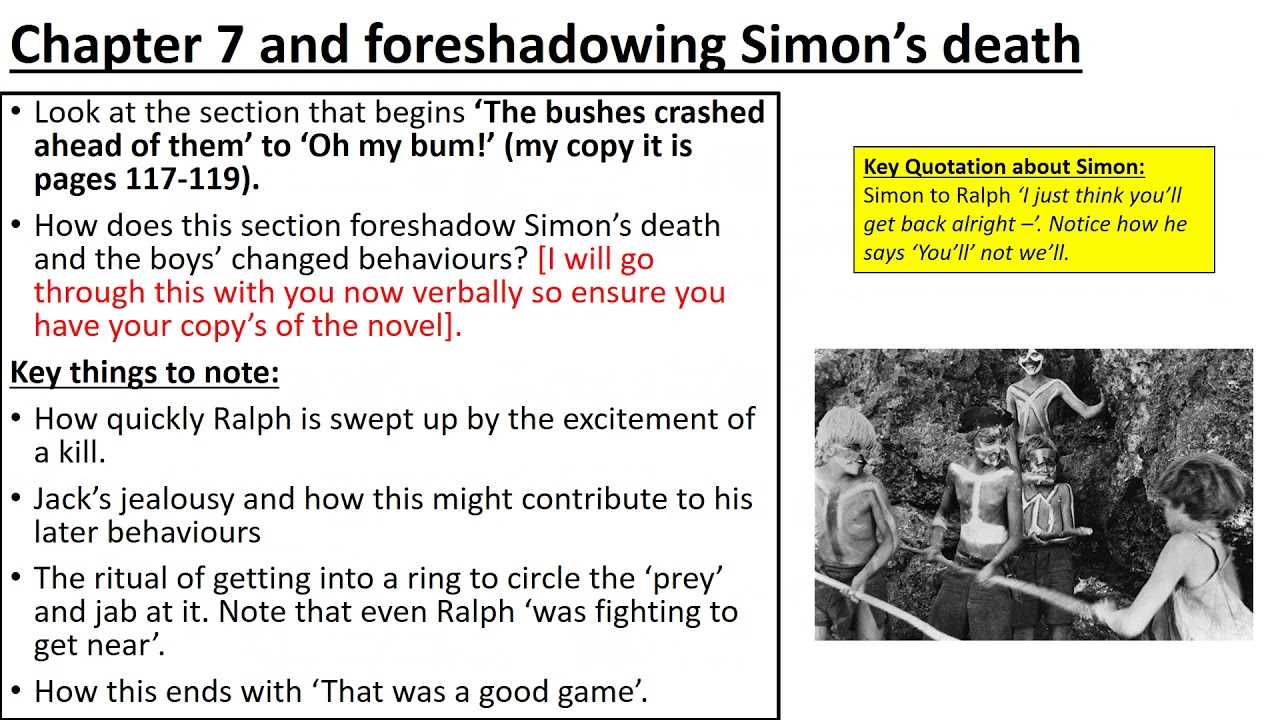
The moment of killing shatters any remaining sense of innocence the boys may have had. What was once a cohesive group with shared goals becomes fractured, as the violent act forces them to confront the brutal side of human nature. This loss of innocence is especially evident in characters who were initially reluctant to partake in such acts. They are now irreversibly changed by the violence they have witnessed or been part of.
Division Among the Boys
As the group splinters, so does the sense of unity. Some boys, led by Jack, begin to embrace their darker impulses and revel in the newfound power violence brings. Others, like Ralph, struggle to hold on to the ideals of civilization, only to find that their influence is slipping away. This rift deepens, leading to greater hostility and alienation within the group, which ultimately drives them further from their original goals of rescue and survival.
Psychological Effects: The murder deeply impacts the psychological state of the boys. The intense fear, guilt, and excitement that follow the act leave emotional scars that define their behavior moving forward. The group no longer functions as it once did, and the consequences of this turning point will shape their futures in devastating ways.
In conclusion, the killing signifies a loss of moral direction, a fracturing of the group, and the unleashing of untamed, destructive impulses. This moment marks a turning point in their descent into chaos, with irreversible effects on their relationships, their behavior, and their collective psyche.
How Chapter 9 Highlights Human Nature
The events in this section of the story offer a stark examination of humanity’s darker impulses. As social order crumbles and fear escalates, the characters’ true instincts begin to surface. What was once a group of boys striving for civilization rapidly transforms into a scene where survival, power, and primal urges dominate. Through their actions and interactions, the narrative exposes the raw, uncontrollable elements of human nature that emerge in times of crisis.
The Collapse of Social Order
As the boys increasingly reject the rules and norms that once held them together, their behavior becomes more erratic and driven by emotion. What once seemed like a structured attempt to maintain a semblance of civilization unravels, revealing the fragility of social order. This breakdown underscores the idea that civilization is a thin veneer, easily stripped away when fear and power take precedence over reason.
The Role of Fear in Shaping Actions
Fear plays a pivotal role in triggering the descent into chaos. When the boys face the unknown, they become vulnerable to their imaginations, which leads them to irrational conclusions. This fear is not just a response to the external environment but is also rooted in their internal uncertainties. The terror they feel pushes them to act in ways that they might otherwise avoid, highlighting how deeply fear can influence human behavior, often with disastrous consequences.
Violence as an Expression of Power: The violent act committed during this section further emphasizes how individuals can be swayed by the desire for power. The boys’ need to assert dominance over each other, as well as over the imagined threats they perceive, reveals how easily people can be drawn to destructive behaviors when they feel powerless or threatened.
The Dangers of Groupthink: In this moment of intense fear, the group’s collective mentality leads to decisions that individuals, in their right minds, might not have made. The sense of belonging to a group becomes more important than moral considerations, further illustrating how human nature is shaped by external pressures and group dynamics.
Ultimately, this part of the story reflects a critical view of human nature, showing how fear, power struggles, and the loss of order can expose the primal side of individuals. The violence and chaos that ensue are a testament to the fragile balance between civilization and savagery within every person.
What the Characters Learn from Chapter 9
The events in this section reveal significant lessons for the characters, particularly regarding their relationship with power, fear, and their own identities. As the narrative unfolds, each character is forced to confront uncomfortable truths about themselves and their survival instincts. The experiences in this part of the story serve as a turning point in their understanding of human nature and the world around them.
Ralph’s Realization of Powerlessness
Ralph learns the painful truth about his inability to maintain control over the group. Despite his initial efforts to bring order and civility, he begins to see how easily the others are swayed by fear and the promise of power. His idealism shatters as he realizes that his influence is slipping away, and that the boys are increasingly drawn to Jack’s more primal leadership style.
- Ralph’s growing helplessness is evident as he recognizes that the group has moved beyond the point of reason and rational decision-making.
- He also understands that his position as leader has become tenuous, as Jack’s approach to leadership is based on fear and dominance.
Jack’s Understanding of Dominance
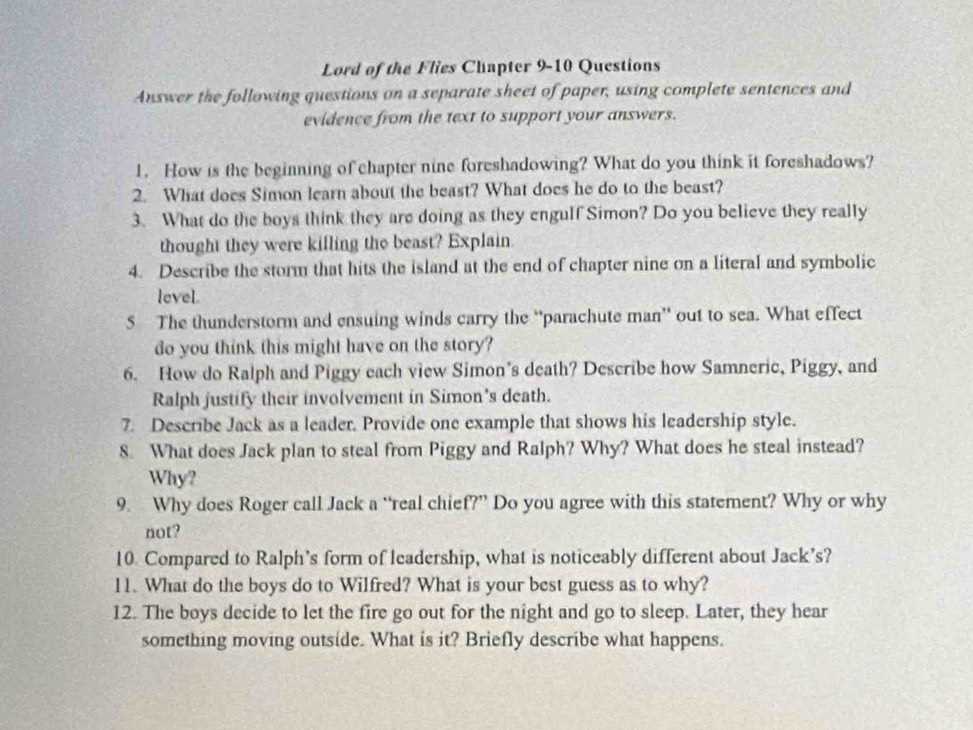
Jack, on the other hand, gains a deeper understanding of how to manipulate fear and violence to assert control. His embrace of savagery is fully realized in this part of the story, and he recognizes the power that comes with inspiring terror in others. Jack’s lessons revolve around his ability to incite the group into action, using intimidation and the promise of safety to solidify his position of power.
- He learns that in times of crisis, a leader who appeals to base instincts–such as fear and aggression–can easily manipulate others.
- His thirst for dominance grows, and he begins to view power as a means of survival and control, rather than a responsibility to the group.
The Impact on the Group’s Unity
For the group as a whole, this moment marks the breakdown of unity and the rise of division. The lessons they learn are not always obvious, but they are felt deeply. The act of violence forces the boys to confront the darkness within themselves, leading some to embrace savagery while others remain conflicted. This division deepens their sense of fear and mistrust, pushing them further away from the idea of working together for mutual survival.
- The boys learn that, in the absence of clear leadership, chaos can quickly take hold, and decisions are made not based on reason but on emotion and fear.
- Those who remain loyal to the ideals of civilization are left struggling, while others embrace the freedom and power that comes with rejecting social norms.
Ultimately, the characters learn harsh lessons about human nature and the fragility of order. The realization that fear, power, and aggression shape their decisions forces them to reckon with the consequences of their actions and the dangers of losing control.
The Breakdown of Society in Chapter 9
In this part of the story, the fragile structures of social order and civility disintegrate as fear, chaos, and power struggles take center stage. What was once an organized effort to survive and create a society based on rules quickly devolves into anarchy. The disintegration of this society is symbolized by the boys’ increasing descent into violence and irrational behavior, marking a turning point where the bonds of cooperation are completely shattered.
The Erosion of Leadership
As fear intensifies, the characters’ understanding of leadership becomes warped. Ralph, who once sought to maintain peace and order, faces the reality that his authority is no longer respected. His efforts to instill discipline are undermined by the growing influence of Jack, whose more brutal and authoritarian approach is becoming increasingly attractive to the boys.
- Ralph’s authority weakens as he is unable to curb the rise of Jack’s more primal leadership style.
- Jack, on the other hand, exploits fear and violence to consolidate power, leading to further fractures within the group.
- The struggle for control between Ralph and Jack exposes the collapse of any semblance of cooperative leadership.
Fear as a Catalyst for Chaos
Fear becomes the driving force behind many of the group’s actions. The boys’ fears of the unknown–whether it’s the imagined “beast” or their growing isolation–fuel irrational decisions that further weaken the structure they had tried to build. As fear takes hold, it becomes a tool used to manipulate others, with some embracing it as a means of survival and control.
- Fear allows individuals to disregard reason and logic, pushing them to act impulsively and violently.
- The group’s inability to cope with their fear leads to the breakdown of any organized effort to stay united.
- The fear of external threats, coupled with the absence of clear leadership, causes the group to lose sight of their initial goals and devolve into chaos.
In this pivotal section, the collapse of society is a powerful commentary on the fragility of human order when faced with overwhelming fear and unchecked aggression. The boys’ descent into savagery highlights the ease with which civility can unravel when the conditions for cooperation no longer exist. Through this breakdown, the narrative underscores how easily human nature can regress in the absence of structured leadership and mutual respect.
Why Piggy’s Role Weakens in Chapter 9
Throughout the story, Piggy’s intellectual approach to problem-solving and his insistence on maintaining order are key traits that define him. However, as fear and chaos take over the group in this section, his position within the group becomes increasingly fragile. His physical limitations, coupled with the group’s growing rejection of rationality in favor of power and primal instincts, contribute to the erosion of his influence.
As the tension between Ralph and Jack escalates, Piggy’s voice becomes less relevant, overshadowed by the rise of violence and authoritarian control. Despite his attempts to appeal to reason, his ideas are no longer enough to sway the group, highlighting the collapse of rational thought in the face of escalating brutality.
Physical Limitations and Growing Isolation
Piggy’s physical vulnerability has always made him stand out among the boys, but in this part of the narrative, his inability to protect himself or assert authority becomes more pronounced. His reliance on others for physical protection undermines his authority and isolates him further from the rest of the group.
| Aspect | Impact |
|---|---|
| Physical Vulnerability | His inability to defend himself diminishes his presence and influence among the boys. |
| Dependence on Others | Piggy’s reliance on Ralph for protection and leadership weakens his own role and perception among the group. |
The Shift Toward Authoritarian Leadership
As Jack’s authoritarian rule becomes more dominant, Piggy’s rational perspective is increasingly dismissed. The group’s attraction to Jack’s aggressive style of leadership marginalizes Piggy’s voice, as they are no longer interested in following reason or cooperative decision-making. This shift signifies a rejection of intellectualism in favor of brute force and dominance.
- Jack’s rise to power represents the group’s move away from reason and civilization toward a more primal form of rule.
- Piggy’s efforts to maintain a sense of order become ineffective as the group embraces chaos over reasoned discussion.
- The rejection of Piggy’s influence highlights the collapse of any remaining structure or semblance of democracy within the group.
In this pivotal moment, Piggy’s weakening role underscores the vulnerability of intellectualism when faced with overwhelming aggression and power. His inability to adapt to the new dynamics within the group marks a significant moment in the novel, as the balance of power shifts entirely toward those who embrace violence and control over logic and cooperation.
The Influence of Fear on Group Behavior
Fear plays a pivotal role in shaping the actions and decisions of individuals within a group. In this context, the growing sense of terror causes a shift in the dynamics of the group, overriding reason and pushing them toward irrational and violent behavior. As anxiety spreads, it leads to chaos, diminishing any attempts at cooperation and unity, and heightening the sense of division among the boys.
Initially, fear manifests as a collective concern about an imagined creature, but as the tension escalates, it becomes a driving force for all their actions. The group’s responses to fear lead them to abandon civility and embrace survival instincts, ultimately resulting in the breakdown of order and the rise of aggression.
The Role of Fear in Disrupting Rational Thought
Fear clouds judgment, causing individuals to abandon reason in favor of impulsive reactions. As members of the group become more fearful, they gravitate toward what offers them the illusion of safety, even if it means surrendering control to more dominant, aggressive forces.
- Fear makes individuals susceptible to manipulation by those who promise protection or power.
- Rational decisions are replaced by reactive actions driven by a desire for immediate relief from fear.
- The growing anxiety prevents any coherent plans or peaceful discussions, pushing the group toward chaos.
Fear’s Impact on Group Unity and Conflict
The growing fear creates a divide within the group, where unity disintegrates, and conflict intensifies. As fear takes hold, the boys turn against each other, creating factions that compete for dominance and control. This division is amplified by the rise of those who exploit fear to further their own agendas, making cooperation and understanding increasingly impossible.
- Fear fosters mistrust, leading individuals to suspect one another rather than collaborate.
- It strengthens leaders who prey on fear, promising security in exchange for loyalty.
- In an environment dominated by fear, cooperation gives way to aggression and self-preservation.
Ultimately, fear serves as a catalyst for the disintegration of social bonds, pushing the group toward destruction. The irrational decisions made under its influence drive individuals to betray their morals, abandon their humanity, and embrace violence, showing how powerful emotions can override logic and cooperation.
How the Chapter Reveals the Theme of Sacrifice
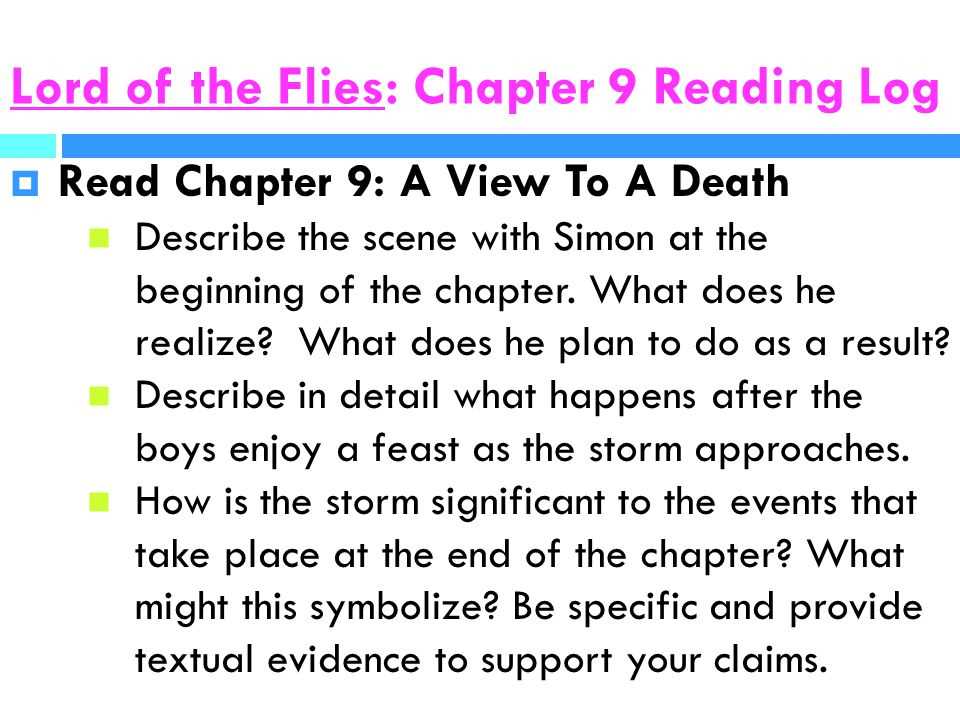
In this part of the narrative, the theme of sacrifice becomes a powerful symbol of both individual and collective struggle. The actions of the characters reflect the broader consequences of giving up something for the perceived good of the group, or as a result of societal pressure. Through these acts, the story explores the tension between personal survival and the greater good, while revealing the darker sides of human nature when faced with dire circumstances.
At its core, sacrifice is depicted as a complex and multifaceted concept, where personal loss and group dynamics intertwine. The events challenge the characters’ morality, forcing them to confront uncomfortable truths about loyalty, power, and survival. This chapter highlights how sacrifices, both intentional and unintentional, play a significant role in shaping the group’s fate.
Symbolic Acts of Sacrifice
Throughout the narrative, certain actions and decisions represent sacrifices made in the name of survival, power, or loyalty. These moments illustrate how the concept of sacrifice can be manipulated to serve a higher cause, even if that cause is destructive or misguided.
- A pivotal act of sacrifice involves giving up individual identity for the benefit of the group, resulting in a loss of morality and self-control.
- Some characters are forced to relinquish their values in an attempt to maintain safety, revealing the dangerous consequences of sacrificing integrity.
- The line between self-preservation and sacrificing for others becomes blurred, leading to destructive outcomes.
Sacrifice as a Catalyst for Conflict
Sacrifice is not always a noble act, especially when it is driven by fear, manipulation, or desperation. In this section, the idea of sacrificing others for personal gain becomes central to the growing conflict within the group. As fear and chaos escalate, characters are driven to make extreme decisions that further fragment the group and solidify their descent into savagery.
- As group unity weakens, sacrifice becomes a tool used by the most powerful to maintain control over others.
- Individuals make sacrifices, either consciously or unconsciously, as they attempt to navigate the increasingly dangerous environment.
- The theme of sacrifice exposes the characters’ inner struggles, revealing the thin line between self-interest and communal responsibility.
The theme of sacrifice in this section underscores the impact of human actions on society as a whole. It highlights how acts of sacrifice can lead to both personal and collective destruction, offering a stark commentary on the lengths individuals are willing to go to in order to survive–or to maintain control over others.
Important Questions Raised in Chapter 9
This section of the story brings forward critical inquiries that challenge the characters’ beliefs, actions, and their understanding of human nature. These questions delve into the moral dilemmas and ethical choices faced by the boys, revealing their struggle between civilization and savagery. As events unfold, the narrative forces readers to confront unsettling truths about power, fear, and the consequences of unchecked violence.
The unfolding drama not only raises doubts about the characters’ intentions but also about the very nature of humanity itself. The pivotal moments of this part of the story leave a lasting impression, prompting reflection on how individuals react under extreme pressure and how society shapes the choices they make.
Key Inquiries about Human Nature
Throughout the events, the behavior of the group presents unsettling questions regarding the essence of human nature. These inquiries challenge the notion of morality and self-restraint, forcing both the characters and readers to reconsider what lies beneath the surface of social conduct.
- What drives individuals to abandon their moral compass in the face of fear and danger?
- Can a group maintain its humanity when primal instincts take over?
- How far can human beings be pushed before they give in to their darkest impulses?
The Influence of Power and Fear
The desire for control, coupled with overwhelming fear, becomes a significant motivator in this part of the story. These elements not only affect group behavior but also introduce questions about how authority is constructed and maintained in times of crisis.
- What role does fear play in shaping the group dynamics and decisions?
- How does one individual’s power affect the collective choices of others?
- Can a sense of authority be maintained when violence and chaos overshadow reason?
As these questions linger throughout the narrative, they draw attention to the complexities of human behavior in extreme situations. The answers remain elusive, but the dilemmas raised challenge us to think critically about the nature of power, fear, and the morality of collective action.
Key Quotes and Their Meanings
This section explores pivotal lines in the narrative that serve to deepen the understanding of the themes and characters. The selected quotes provide insight into the underlying motivations, conflicts, and emotional states that define the trajectory of the story. Each quote unveils layers of meaning, allowing for a closer examination of the characters’ struggles and the larger forces at play within the group dynamic.
By examining these lines, we can better grasp the tension, fear, and loss of innocence that permeates the events. The following selections highlight critical moments where words resonate far beyond their immediate context, echoing broader ideas about human nature and society.
Notable Expressions of Fear and Power
The theme of fear is central to this part of the story, and certain phrases encapsulate its overwhelming influence on the group. These quotes reflect how fear distorts perceptions, drives irrational decisions, and unearths the darker aspects of human behavior.
- “The beast was a hunter” – This line represents the group’s collective fear manifesting as a tangible threat. It highlights how fear can shape reality and fuel violence when left unchecked.
- “We’ll do everything, everything!” – This declaration, made under the influence of fear, illustrates how the group’s sense of unity becomes warped by the need to conform to primal instincts.
The Loss of Innocence
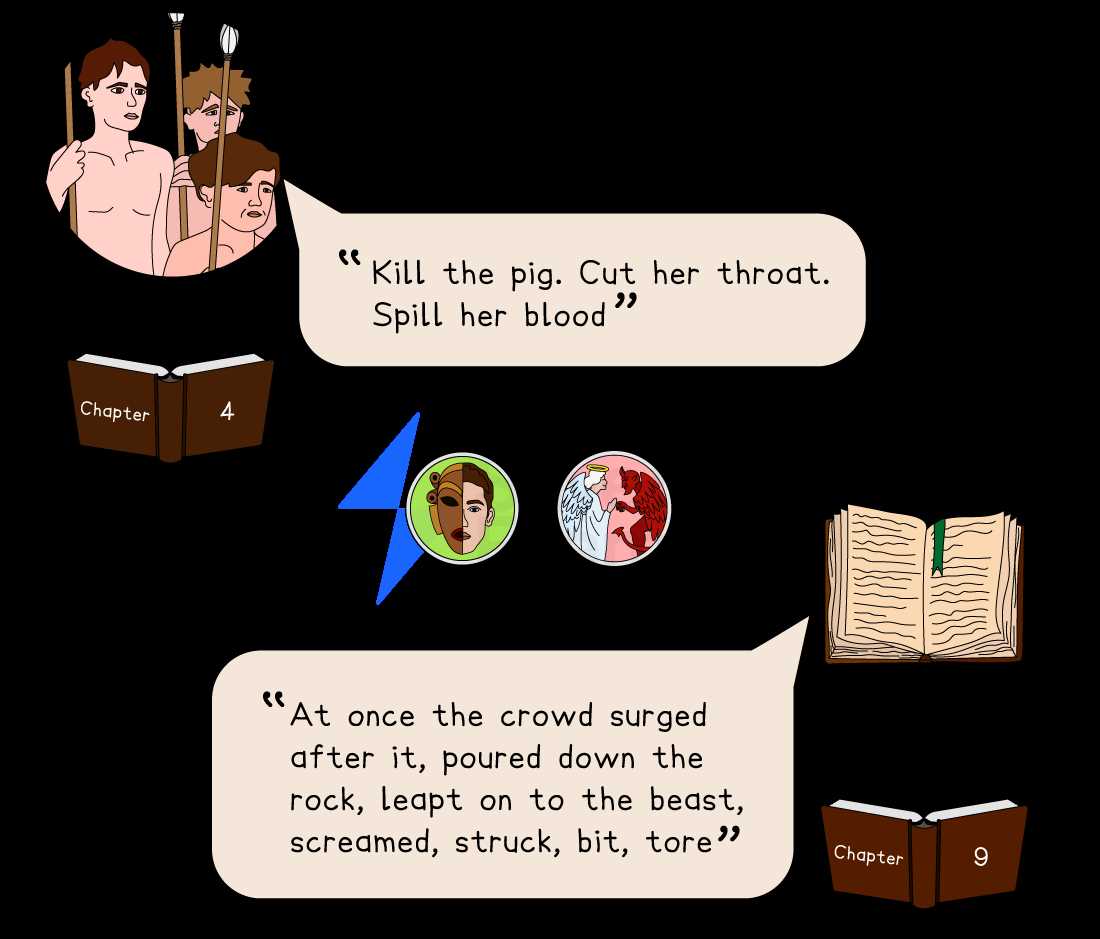
As the story progresses, certain quotes reflect the characters’ loss of innocence and their descent into savagery. These lines mark turning points where previously held beliefs and societal rules break down, making way for the raw expression of human desires and impulses.
- “Maybe there is a beast… maybe it’s only us.” – This powerful line reveals the realization that the true terror lies within the boys themselves, highlighting the internal conflict between their civilized selves and their darker nature.
- “The world, that understandable and lawful world, was slipping away.” – This quote marks a critical moment when the boys are no longer able to maintain their connection to the structures of civilization, symbolizing their total breakdown.
These key lines not only reveal the emotional and psychological states of the characters but also enrich the narrative, offering readers a deeper understanding of the universal themes explored in the story.
The Aftermath of Simon’s Murder
The tragic event marks a pivotal turning point, casting a long shadow over the remaining boys. In the immediate aftermath, the group is forced to confront the consequences of their collective actions. The murder of an innocent member, driven by fear and hysteria, has far-reaching effects, not only on the characters involved but also on the group’s dynamic and sense of morality. This section delves into the emotional and psychological impact of Simon’s death and its implications for the group’s future.
Despite the immediate chaos, some characters begin to process the gravity of what transpired. However, many continue to deny or deflect responsibility, unable to fully comprehend the extent of their involvement. The subsequent reactions reveal much about the nature of guilt, survival, and the loss of innocence among the group members.
Impact on Key Characters
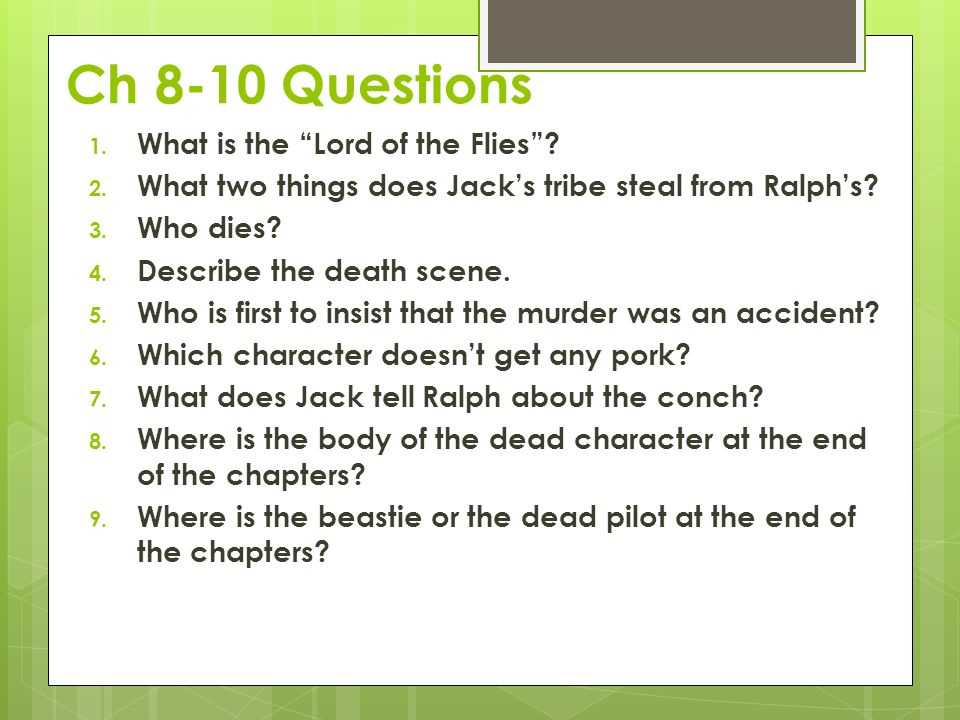
Simon’s murder leaves a lasting impression on certain characters, shaping their actions and attitudes in the coming events. Below is an overview of how the aftermath affects them:
| Character | Reaction |
|---|---|
| Ralph | Ralph is filled with guilt and remorse but struggles to accept his role in the violence. He becomes more introspective and conflicted about his leadership. |
| Jack | Jack shows no remorse and instead continues to assert his dominance, using the murder to solidify his control over the group and stoke further fear. |
| Piggy | Piggy is frightened by what has happened but chooses to rationalize it, distancing himself from the event and focusing on the need for order and civility. |
| Sam and Eric | Sam and Eric are overwhelmed with fear and guilt, but they fall in line with Jack’s leadership, unable to break away from the violent group dynamic. |
The Shift in Group Dynamics
Simon’s death accelerates the breakdown of civility and the shift toward savagery. The boys, who were once united by the idea of rescue and survival, now become further divided. Fear, anger, and violence begin to dictate their actions, and the sense of camaraderie is replaced by a power struggle. This fracture will only deepen as the group’s cohesion weakens and the boys increasingly embrace their primal instincts.
In conclusion, Simon’s tragic end serves as a catalyst for the deterioration of the group’s moral compass. The aftermath underscores the central theme of humanity’s inner darkness, revealing how easily individuals can be swept away by their baser instincts when fear and chaos prevail.